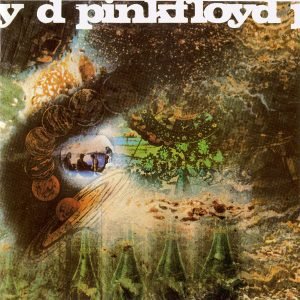Released in 1968, “A Saucerful of Secrets” stands as a pivotal moment in Pink Floyd’s discography, marking a transition from the psychedelic pop of their debut, “The Piper at the Gates of Dawn,” to the more expansive, experimental sounds that would define their later work. This second studio album is the only one to feature all five members of Pink Floyd: Syd Barrett, Roger Waters, Nick Mason, Richard Wright, and the newly inducted David Gilmour, who would later become a cornerstone of the band.
In the broader music landscape of the late 1960s, “A Saucerful of Secrets” emerged during a time of rapid innovation and exploration. Psychedelic rock was at its peak, with bands like The Beatles and The Jimi Hendrix Experience pushing the boundaries of what rock music could be. Pink Floyd’s contribution to this era was unique, blending their early psychedelic influences with a burgeoning interest in avant-garde and experimental soundscapes.
Artistic Intentions
Artistically, “A Saucerful of Secrets” represents both a continuation and a departure. While it retains the whimsical, otherworldly essence of their debut, it also delves deeper into themes of madness, space, and existential angst—topics that would become central to their identity. The departure of Syd Barrett due to mental health issues and the introduction of David Gilmour led to a shift in the band’s dynamics and sound. This album captures that transitional energy, with Barrett’s eccentric genius still echoing in tracks like “Jugband Blues,” while Gilmour’s influence begins to steer the band towards more structured and melodic compositions.
The artistic intentions behind “A Saucerful of Secrets” were multifaceted. The band sought to push the envelope of what rock music could express, both sonically and thematically. This is evident in the album’s title track, a nearly 12-minute instrumental suite that explores a range of moods and textures, from chaotic crescendos to serene, meditative passages. According to interviews and album notes, Pink Floyd aimed to create an immersive, almost cinematic listening experience that transcended the conventional song structures of the time. They were interested in exploring the limits of studio technology, using innovative recording techniques to create a sound that was as expansive and mysterious as the themes they were exploring.
Sonic Exploration

Production Quality
The production quality of “A Saucerful of Secrets” is a fascinating blend of meticulous craftsmanship and experimental audacity. Recorded at EMI’s Abbey Road Studios, the album benefits from the technical expertise of Norman Smith, who also worked with The Beatles. The production is notably more polished than their debut, reflecting a clearer, more refined sound. Yet, it still embraces the raw, unfiltered energy of the psychedelic era.
The album’s production values align perfectly with its thematic ambitions. The use of stereo panning, reverb, and tape effects creates a soundscape that feels expansive and immersive. This is particularly evident in tracks like “Set the Controls for the Heart of the Sun,” where the ethereal production enhances the song’s cosmic, otherworldly atmosphere. The juxtaposition of crisp, clear instrumentation with more distorted, ambient elements mirrors the album’s exploration of the boundaries between sanity and madness, reality and fantasy.
Musical Arrangements
Musically, “A Saucerful of Secrets” showcases Pink Floyd’s evolving mastery of arrangement and instrumentation. The album’s title track, a nearly 12-minute instrumental suite, epitomizes their experimental approach. It is divided into four distinct sections, each with its own mood and texture. From the cacophonous opening to the serene, organ-driven finale, the arrangement takes listeners on an emotional and sonic journey.
“Remember a Day,” written and sung by Richard Wright, features a delicate arrangement with layered vocals, whimsical piano lines, and a melancholic slide guitar by Gilmour. The interplay of these elements creates a nostalgic, dreamlike quality that stands out as one of the album’s most poignant moments.
“Jugband Blues,” Syd Barrett’s swan song with the band, is another highlight in terms of arrangement. The song juxtaposes a traditional folk melody with dissonant brass sections and a chaotic outro, reflecting Barrett’s fragmented state of mind. This innovative arrangement underscores the song’s lyrical themes of alienation and confusion.
Genre Elements
“A Saucerful of Secrets” touches upon several musical genres, blending them in ways that were innovative for its time. The album is rooted in psychedelic rock, evident in its use of unconventional song structures, experimental sound effects, and surreal lyrics. However, it also foreshadows the band’s future forays into progressive rock, with extended instrumental passages and complex compositions.
Tracks like “Set the Controls for the Heart of the Sun” and “A Saucerful of Secrets” incorporate elements of space rock, characterized by their expansive, ambient soundscapes and themes of cosmic exploration. The album’s blending of these genres was quite novel at the time, setting the stage for the progressive rock movement of the 1970s.
Moreover, the album does not entirely abandon the band’s earlier influences. The whimsical, pastoral quality of “Remember a Day” and “See-Saw” harks back to the British folk and pop sensibilities of their debut. Yet, these songs are imbued with a darker, more introspective edge, reflecting the band’s evolving artistic vision.
Lyrical Analysis

Themes and Messages
The central themes of “A Saucerful of Secrets” are multifaceted, reflecting the turbulent period in which it was created. The album grapples with concepts of madness, existential dread, and cosmic exploration, echoing the personal and artistic transitions within Pink Floyd at the time. Syd Barrett’s departure due to mental health struggles deeply influenced the thematic content, infusing the lyrics with a sense of loss and fragmentation.
“Set the Controls for the Heart of the Sun,” penned by Roger Waters, delves into themes of cosmic journey and introspection. The lyrics, inspired by ancient Chinese poetry, explore the vastness of space and the human condition’s insignificance within it. Lines like “Witness the man who raves at the wall / Making the shape of his questions to heaven” convey a sense of existential questioning and the search for meaning in the universe.
In “Jugband Blues,” Syd Barrett’s last contribution to the band, the theme of alienation is poignantly expressed. The lyrics are a haunting reflection of Barrett’s own mental state, with lines like “It’s awfully considerate of you to think of me here / And I’m much obliged to you for making it clear that I’m not here.” This song serves as a farewell, encapsulating Barrett’s feelings of disconnection and confusion.
Lyrical Depth
The lyrics on “A Saucerful of Secrets” are characterized by their poetic and abstract nature. Unlike conventional narrative songwriting, the album’s lyrics often embrace ambiguity and surrealism, inviting multiple interpretations. This approach aligns with the psychedelic ethos of the time, where lyrics were intended to evoke a mood or atmosphere rather than tell a straightforward story.
Roger Waters’ contributions, such as “Set the Controls for the Heart of the Sun,” demonstrate a deep engagement with literary and philosophical themes. The use of archaic language and imagery lends the lyrics a timeless quality, encouraging listeners to ponder the vast, often incomprehensible nature of existence.
Syd Barrett’s lyrics, on the other hand, are more fragmented and whimsical, yet they possess a haunting beauty. In “Jugband Blues,” the seemingly disjointed phrases come together to form a poignant commentary on his mental decline. The simplicity of the words contrasts with their profound emotional weight, highlighting Barrett’s unique lyrical genius.
Emotional Impact
The emotional impact of the lyrics on “A Saucerful of Secrets” is profound, contributing significantly to the album’s overall resonance. The themes of madness, loss, and existential angst evoke a deep sense of empathy and contemplation. Barrett’s raw and vulnerable lyrics in “Jugband Blues” are particularly moving, offering a glimpse into his troubled psyche and leaving a lasting impression on the listener.
Roger Waters’ existential musings in “Set the Controls for the Heart of the Sun” and “Let There Be More Light” evoke a sense of awe and introspection. The cosmic imagery and philosophical questions posed in these songs invite listeners to reflect on their place in the universe, creating an emotional experience that is both unsettling and enlightening.
In “Remember a Day” and “See-Saw,” Richard Wright’s lyrics explore themes of nostalgia and melancholy. These songs evoke a bittersweet longing for the past, their gentle melodies and poetic lyrics creating a dreamlike, reflective atmosphere.
Cohesion and Flow

Track Progression
The progression of tracks on “A Saucerful of Secrets” is a carefully crafted journey through varying moods and sonic landscapes, creating a seamless flow that enhances the album’s overall impact. The opening track, “Let There Be More Light,” sets the stage with its gradual build-up from a brooding bassline to an intense, swirling crescendo. This track transitions smoothly into “Remember a Day,” where the pace slows and the mood becomes more reflective, offering a contrast that underscores the album’s dynamic range.
As the album progresses, each track feels like a natural evolution from the previous one. “Set the Controls for the Heart of the Sun” continues the ethereal, spacey vibe introduced in the opening track but with a more meditative and hypnotic quality. This leads into “Corporal Clegg,” a more upbeat and whimsical song that provides a moment of levity without breaking the album’s overall cohesion.
The title track, “A Saucerful of Secrets,” serves as the album’s centerpiece. Its multi-part structure and experimental nature encapsulate the themes and styles explored throughout the album, creating a pivotal moment that ties the previous tracks together and sets the tone for the latter half. The transition from the chaotic segments to the serene, organ-led conclusion mirrors the album’s broader emotional journey.
Following the title track, “See-Saw” and “Jugband Blues” bring the album to a contemplative and poignant close. “See-Saw” maintains the reflective, melancholic atmosphere, while “Jugband Blues” provides a fitting, if bittersweet, conclusion with its raw and introspective lyrics. The final moments of “Jugband Blues” leave the listener with a sense of unresolved tension, reflecting the album’s exploration of mental fragmentation and cosmic uncertainty.
Thematic Consistency
“A Saucerful of Secrets” maintains a remarkable thematic and stylistic consistency throughout its duration. The album’s exploration of madness, cosmic vastness, and existential angst is woven into each track, creating a cohesive narrative that ties the work together. While the individual songs vary in tempo and mood, they all contribute to the overarching themes, ensuring that the album feels like a unified piece rather than a collection of disparate tracks.
The psychedelic and experimental elements present in the instrumentation, production, and lyrical content create a signature sound that persists throughout the album. This consistency is further reinforced by the band’s use of recurring motifs, such as space and introspection, which are explored from different angles across the tracks.
Despite the diversity in song styles, from the serene “Remember a Day” to the experimental title track and the whimsical “Corporal Clegg,” the transitions between songs are handled with care. The shifts in tone and tempo feel purposeful, adding to the album’s narrative rather than detracting from it. Each song contributes to the overall atmosphere of the album, ensuring that there are no jarring shifts that might disrupt the listener’s immersion.
Standout Tracks and Moments
Highlight Key Tracks
Several tracks on “A Saucerful of Secrets” stand out for their artistic merit, innovation, and emotional impact, each contributing uniquely to the album’s overarching themes and sonic exploration.
“Set the Controls for the Heart of the Sun”
This track is a masterpiece of atmospheric tension and cosmic introspection. Its hypnotic rhythm, driven by Nick Mason’s steady drumming and Roger Waters’ pulsating bassline, creates a meditative and otherworldly ambiance. The song’s hauntingly sparse lyrics, inspired by ancient Chinese poetry, add to its enigmatic allure. The blend of eastern musical influences with psychedelic rock elements makes it a standout piece that encapsulates the band’s innovative spirit.
“A Saucerful of Secrets”
The title track is a monumental work of experimental rock. Its nearly 12-minute runtime is divided into four distinct sections: “Something Else,” “Syncopated Pandemonium,” “Storm Signal,” and “Celestial Voices.” This instrumental suite takes the listener on a journey through chaos and calm, showcasing the band’s ability to create complex and emotionally resonant music without the need for lyrics. The transition from the tumultuous middle sections to the serene, hymn-like conclusion is particularly powerful, exemplifying the band’s skill in crafting dynamic and evocative soundscapes.
“Jugband Blues”
Syd Barrett’s final contribution to Pink Floyd is a poignant and deeply personal song. Its whimsical yet melancholic melody, coupled with Barrett’s introspective lyrics, creates an emotional resonance that is hard to forget. The line “And I’m wondering who could be writing this song” poignantly reflects Barrett’s sense of detachment and confusion. The abrupt shifts in musical style within the track, from folk to brass band to a dissonant outro, mirror Barrett’s fragmented mental state, making it a standout moment on the album.
Memorable Moments
David Gilmour’s Slide Guitar on “Remember a Day”
David Gilmour’s slide guitar work on “Remember a Day” is a highlight that showcases his lyrical and expressive playing style. The wistful, almost mournful quality of the slide guitar complements Richard Wright’s nostalgic lyrics perfectly, adding depth to the song’s emotional impact. This moment not only highlights Gilmour’s talent but also signals his growing influence within the band.
The Climax of “A Saucerful of Secrets”
The climax of the title track, particularly the transition from “Storm Signal” to “Celestial Voices,” is a defining moment on the album. The shift from chaotic, almost apocalyptic sounds to a serene, organ-driven melody is breathtaking. This moment captures the essence of the album’s exploration of chaos and order, madness and clarity. The use of silence and gradual build-up in “Celestial Voices” creates an overwhelming sense of resolution and peace, making it one of the most memorable passages in Pink Floyd’s early catalog.
Roger Waters’ Bassline on “Let There Be More Light”
The opening bassline of “Let There Be More Light” is another standout moment. Its dark, driving groove sets the tone for the entire album, combining with Richard Wright’s eerie keyboard lines to create a sense of anticipation and mystery. This bassline not only anchors the track but also introduces the listener to the album’s thematic exploration of light and darkness, space and time.
Syd Barrett’s Farewell in “Jugband Blues”
The closing moments of “Jugband Blues,” with Barrett’s resigned and haunting delivery of “What exactly is a joke?”, leave a lasting impression. This line, and the fragmented, almost disjointed nature of the song, encapsulate Barrett’s troubled genius and the sense of loss that permeates the album. It serves as a poignant farewell to Barrett’s contributions to Pink Floyd, making it a deeply moving and unforgettable moment.
Artistic Contribution and Innovation

Place in Genre/Industry
“A Saucerful of Secrets” occupies a significant place within the psychedelic rock genre and the broader music industry of the late 1960s. At a time when many bands were exploring the limits of rock music, Pink Floyd’s second album pushed the boundaries further with its avant-garde approach to composition and sound. It diverged from the more commercial and accessible psychedelic pop of their debut, “The Piper at the Gates of Dawn,” venturing into uncharted territories of experimental rock.
In the context of its genre, “A Saucerful of Secrets” was a bold statement that helped redefine what psychedelic rock could encompass. While many contemporary bands were focused on creating catchy, acid-infused anthems, Pink Floyd delved deeper into the abstract and cerebral aspects of the genre. Their use of extended instrumental passages, unconventional song structures, and a blend of space rock and progressive elements distinguished them from their peers.
Within the music industry at large, the album represented a shift towards more serious and artistically ambitious projects. It demonstrated that rock music could be a vehicle for complex, multi-layered compositions and thematic depth, paving the way for future progressive rock acts. By embracing both the experimental and the emotive, “A Saucerful of Secrets” contributed to the evolution of rock music as an art form.
Innovation
The album is noteworthy for several innovative aspects that set it apart from other works of its time, influencing both its genre and the broader music landscape.
Experimental Production Techniques
“A Saucerful of Secrets” features a range of innovative production techniques that were ahead of their time. The band and producer Norman Smith employed various studio effects to create a rich and immersive soundscape. Techniques such as reverse tape effects, extensive use of reverb, and innovative stereo panning are prominent throughout the album. These methods contributed to the album’s ethereal and otherworldly atmosphere, enhancing its thematic focus on space and existential exploration.
Pioneering Use of Instrumentation
The album’s instrumental diversity and arrangements are particularly innovative. The title track, “A Saucerful of Secrets,” is a prime example, featuring an array of sounds and textures that blend seamlessly to create a cohesive piece. The track’s use of avant-garde elements like dissonant piano chords, eerie organ passages, and layered percussion was groundbreaking. It showcased the band’s willingness to experiment with different sounds and their ability to integrate these experiments into their music effectively.
Thematic Depth and Complexity
Thematically, the album broke new ground by addressing complex and often dark subjects such as madness, existential dread, and cosmic insignificance. These themes were not typically explored in popular music at the time, and Pink Floyd’s willingness to tackle them head-on was both daring and innovative. This thematic depth is particularly evident in “Set the Controls for the Heart of the Sun” and “Jugband Blues,” where the lyrics delve into introspective and philosophical realms.
Integration of Syd Barrett’s Unique Vision with New Directions
The album also represents an innovative merging of Syd Barrett’s whimsical, surrealistic approach with the emerging musical directions influenced by David Gilmour. While Barrett’s influence is still palpable, especially in “Jugband Blues,” the album begins to lean towards the more structured and melodic contributions of Gilmour. This integration of different artistic visions was a novel approach that allowed the band to transition smoothly from their early psychedelic phase to their later, more progressive works.
Closing Thoughts

“A Saucerful of Secrets” is a landmark album that captures Pink Floyd at a crucial juncture in their career, balancing the psychedelic whimsy of their early work with the burgeoning experimentalism that would define their future. Its strengths lie in its ambitious exploration of sound and theme, its innovative production techniques, and its emotional depth. Tracks like “Set the Controls for the Heart of the Sun” and the title track showcase the band’s ability to create immersive and thought-provoking musical landscapes, while “Jugband Blues” offers a poignant glimpse into Syd Barrett’s troubled genius.
The album’s production is a standout feature, with Norman Smith’s expertise helping to craft a sonic environment that is both expansive and intimate. The use of unconventional instrumentation and studio effects adds layers of complexity and intrigue to the listening experience. Moreover, the thematic consistency and emotional resonance of the lyrics deepen the album’s impact, inviting listeners to engage with its exploration of cosmic and existential questions.
Weaknesses
However, “A Saucerful of Secrets” is not without its weaknesses. The album’s experimental nature can sometimes lead to moments of disjointedness, particularly in the more abstract sections of the title track. Additionally, the transition from Syd Barrett’s influence to David Gilmour’s more structured approach creates a sense of unevenness, as the band navigates its evolving identity. Some listeners might find this transitional quality challenging, as it lacks the cohesive polish of later albums like “Dark Side of the Moon.”
Despite these minor drawbacks, “A Saucerful of Secrets” stands as a testament to Pink Floyd’s willingness to push the boundaries of rock music. It is a bold and innovative work that lays the groundwork for the band’s future masterpieces, showcasing their talent for blending the experimental with the emotionally resonant.
Official Rating
An 8 out of 10 rating reflects the album’s significant artistic achievements and its pivotal role in Pink Floyd’s discography. While it may not possess the refined cohesion of their later works, its innovative spirit and emotional depth make it a compelling and essential listen. “A Saucerful of Secrets” offers a fascinating glimpse into a band in transition, capturing the creative tensions and explorations that would ultimately lead to their most iconic albums. For listeners and fans, it is a powerful and intriguing piece of Pink Floyd’s musical journey, deserving of appreciation and respect for its contributions to the evolution of rock music.
